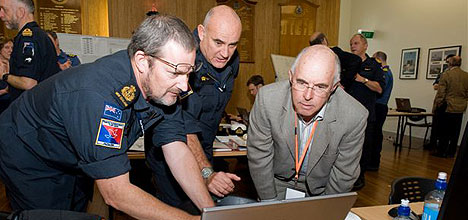The Port of Tauranga was involved in a New Zealand first as the Royal New Zealand Navy hosted Exercise Bell Buoy – an international maritime operation involving 10 Pacific nations.
The International Trade Protection exercise involved participants from 10 other nations and utilised the Ports of Auckland, Tauranga, Whangarei and Marsden Point from May 13 to May 24.
Exercise Bell Buoy was undertaken last week involving ports in Tauranga, Whangarei and Auckland.

Based in the fictional country of Navaki, located a day's sailing to the north of New Zealand, Bell Buoy was a successful international exercise that tested new doctrine and generated new capabilities for Navy and the NZDF, says Captain Phil O'Connell.
'We used the port as what it would have been like in 1965, which is reasonably similar to what you would see in ports in most Pacific Island nations today, with logging and some self-sustaining containers and without the big cranes or anything like that.
Throughout the scenario personnel had to deal with a number of issues including providing assistance with aid agencies for humanitarian shipping, and providing security on the ground while working with the wider defence force in making the port available for both the military and aid agencies.
'Key highlights for the participants included the establishment of key elements required in a Joint and Combined Task Force Headquarters to support a humanitarian relief mission, develop and implement a safety of navigation information system, and provide advice to mariners of sea robbery and piracy threats,” says Phil.
'We were able to learn from that experience and we were able to pass on their knowledge to the participating nations.”

In addition to the Rapid Port assessment team, which deployed to Mt Maunganui during the exercise, a small multi-national team was permanently based at Mt Maunganui for the period.
'Working with ships' masters, pilots and other port companies, personnel briefings were conducted and information assessed to create a common operating picture of conditions in the fictional port.
'Working collaboratively, military personnel from the 10 nations established a headquarters in Auckland, and shared experiences and knowledge to adopt and implement a system to provide safety of navigation information to seafarers in an environment where the existing civilian infrastructure and personnel were not available.”
Phil says once established, the focus moved to supporting humanitarian relief and security efforts before identifying sea robbery and piracy risks to maritime trade, and recommending defensive actions to ships masters to ensure the uninterrupted flow of maritime trade.
Naval reservists, alongside regular force navy and army personnel from participating nations, quickly integrated into a cohesive team to deliver the Bell Buoy Exercise objectives.
'Bell Buoy has been highly beneficial, and has also orientated the RNZN Maritime Trade Operations team toward the NZDF objective of a Joint Amphibious Task Force.”
On conclusion of the exercise, Captain Phil O'Connell handed over responsibility to the US Navy for the planning and conduct of Exercise Bell Buoy (the 14th international exercise) and thanked all participating nations, port companies and the maritime industry for their contributions and support.



0 comments
Leave a Comment
You must be logged in to make a comment.